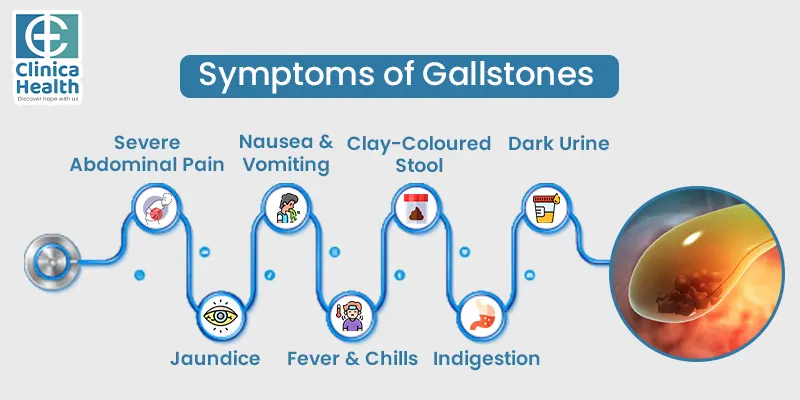Gallbladder Stones – Symptoms, Causes & Treatment
Gallstones, also known as gallbladder stones, are very common digestive problems affecting millions of people worldwide. The gallbladder is a pear-shaped organ located on the right side of the abdomen just beneath the liver.
The primary function of the gallbladder is to store bile, a digestive fluid produced by the liver that helps in the digestion of foods and absorption of fats. However, when there is an imbalance in the substances that make up the bile, it leads to the formation of gallstones.
They often lead to painful conditions if left untreated.
In this blog, we will discuss gallstones in detail, including their symptoms, causes and treatment.
What are Gallstones?
Gallstones are hardened deposits of bile that form in the gallbladder or bile ducts. They vary in shape and size. While some are small and resemble a grain of sand, others might appear large. Gallstones are generally not present with any symptoms in the initial stage; however, over time, they cause serious complications. Moreover, if left untreated, they even cause blockage in the bile ducts, leading to major health problems and even death.
Gallstones are Generally of Two Types:
Cholesterol gallstones: This is the most common type of gallstones. It is mainly yellow in colour and forms when there is excess cholesterol in the bile.
Pigment gallstones: They are darker in colour. It is caused when the bile contains too much bilirubin, which is a byproduct of the breakdown of red blood cells.
Symptoms of Gallstones
Gallstones are asymptomatic i,e they do not cause any troublesome or noticeable signs in individuals, says a reputed gallbaldder surgeon in Kolkata. It is often called the silent killer. However, when symptoms occur, they might cause the following:
Severe abdominal pain: Ache in the upper right or middle upper abdomen, which might last for a long or for short duration. The pain can either be sharp or dull.
Jaundice: This occurs when the gallstones block the bile ducts, thereby preventing its flow into the intestines. As a result, there is an excess buildup of bilirubin, which leads to the yellowing of the skin.
Nausea and vomiting: In some cases, there is persistent nausea and vomiting, especially after eating a large and heavy meal.
Fever and chills: When the gallbladder gets infected, fever and chills will occur, accompanied by other symptoms.
Clay-coloured stool: The stool will appear pale and clay-coloured.
Indigestion: Individuals experience indigestion and bloating after having meals.
Dark urine: If the bile gets blocked, the urine will become dark in colour.

Causes of Gallstones
According to research and the opinion of the best gallbladder surgeon in Kolkata, there are several causes that cause the formation of gallstones.
Obesity: Being overweight or obese increases the amount of cholesterol in the bile and increases the risk of gallstones.
Age: As one ages, especially after 40, there is a chance of gallstone formation.
Genetics: A family history of genetics makes a person more prone to developing gallstones.
Medicines: Certain medications like antibiotics and cholesterol-lowering drugs affect the liver function and cause gallstones.
Diet: Food high in fat and cholesterol contribute to stone formation.
Bilirubin imbalance: Excess bile formation and an inadequate amount of bile salts form stones in the gallbladder.
Complications of Gallstones
If you have gallstones, make sure to get treated by the best gallbladder surgeon in Kolkata. Otherwise, it can result in various complications. Here are some of the major health issues.
Cholecystitis: It is the inflammation of the gallbladder. When the gallstones block the normal flow of bile, the gallbladder becomes irritated and causes permanent damage to the gallbladder.
Gallbladder cancer: Long-term inflammation of the gallbladder makes an individual more prone to suffering from gallbladder cancer.
Bile duct obstruction: Gallstones block the ducts where the bile flows from the liver to the small intestine. This results in pain and liver dysfunction.
Pancreatitis: If gallstones block the pancreatic ducts, it disrupts the normal functioning of the pancreas, which is known as pancreatitis.
Sepsis: If the gallstones lead to infection over time. It eventually causes sepsis, a life-threatening condition that spreads throughout the body and starts affecting the organs.
Can Gallstones make an Individual feel very Tired and Dizzy?
While gallstones do not directly cause fatigue and tiredness, some individuals can experience them as a result of low blood pressure. This is because severe inflammation in the biliary system makes the heart beat faster with a drop in pressure, says a gallbladder surgeon in Kolkata.
Effective Treatment Approaches for Gallstones
The treatment of gallbladder stones begins with an accurate diagnosis to confirm its presence. There are blood tests and imaging procedures which your doctor will recommend you to undergo. It will help in the detection of an infection or inflammation and locate the source of the blockage. Here are the common treatment approaches that gallbladder surgeons in Kolkata mostly suggest.
- Surgery: Also known as cholecystectomy, it involves the removal of the gallbladder. It provides a long-term solution for gallstones. You can either opt for an open method or a laparoscopic procedure.
- Medicines: There are certain medicines that are prescribed by surgeons to dissolve the gallstones.
- Shock wave lithotripsy: This is another technique where the gallstones are blasted into several pieces.
- Lifestyle modifications: This is mandatory for every patient, where they are advised to indulge in a healthy diet, including low-fat, high-fibre food for easy digestion.
Conclusion
Gallstones are common and can cause a lot of damage if left untreated. However, it can be treated by consulting the best gallbladder surgeon in Kolkata. A good doctor will assess your overall health, understand the severity of the condition and suggest the appropriate treatment plan.
 Call Now:
8010 552 552
7595 838 844
Call Now:
8010 552 552
7595 838 844
 Whatsapp Now:
8010 552 552
Whatsapp Now:
8010 552 552
 Email Me:
[email protected]
Email Me:
[email protected]

